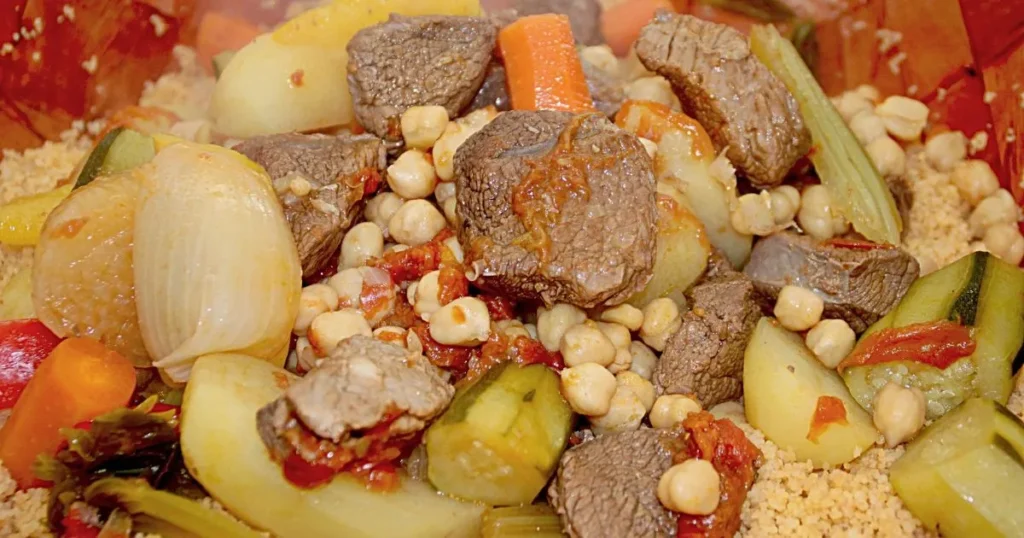The smell of saffron and cumin filled the Marrakech alleyway, drawing me into a world of food magic. My first taste of Moroccan food was amazing—a mix of flavors that changed how I see food. This guide is your ticket to a food adventure you’ll never forget.
Moroccan food is a mix of flavors that tell stories of culture and tradition. You’ll find everything from tasty street food to slow-cooked tagines. This guide will show you the amazing tastes of Morocco’s food scene.
Table of Contents
Key Takeaways
- Discover the diverse flavor profiles of Moroccan cuisine
- Explore dishes rooted in rich cultural traditions
- Learn about unique cooking techniques
- Understand the cultural significance of Moroccan food
- Prepare for a sensory culinary journey
Introduction to Traditional Moroccan Cuisine
Moroccan cuisine is a vibrant mix of flavors and traditions. It tells a story of cultural blending. This journey through moroccan dishes shows a fascinating mix of tastes and cooking methods.
The roots of moroccan cuisine are deep and diverse. It combines influences from many civilizations. This creates a food culture that is rich and meaningful.
Cultural Culinary Influences
The flavors of moroccan cuisine come from different cultures:
- Berber tribes introduced basic cooking techniques
- Arabic traders brought exotic spices and new ingredients
- Mediterranean cultures added coastal cooking methods
Essential Spices in Moroccan Cooking
Spices are the heart of moroccan dishes. They turn simple ingredients into amazing meals. Key spices include:
- Cumin: Adds earthy warmth to many dishes
- Saffron: Provides golden color and delicate flavor
- Ras el hanout: A complex spice blend with up to 30 ingredients
The Art of Communal Dining
Moroccan meals are more than food—they’re social experiences. Sharing meals around a single dish shows hospitality and respect. Families and friends gather, breaking bread and making memories.
Tagine: The Heart of Moroccan Food Guide
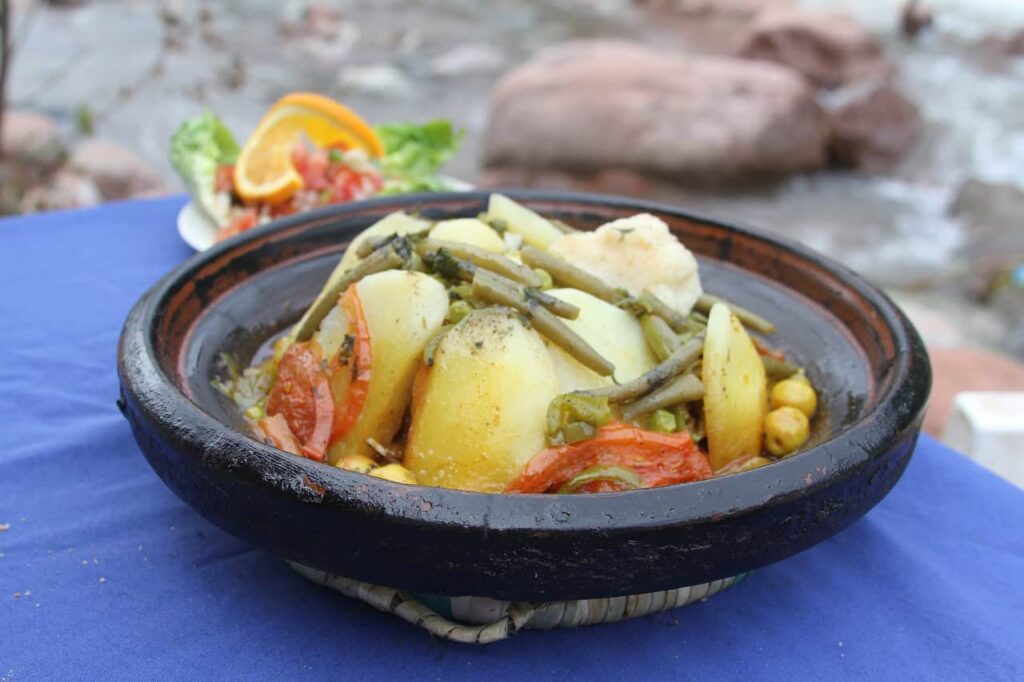
The tagine is a key dish in Moroccan cuisine. It turns simple ingredients into amazing meals. These dishes will make your taste buds dance and take you to Morocco’s lively streets.
The tagine is more than food; it’s a cooking method and a pot. It makes stews that are tender and full of flavor. The clay pot’s shape helps steam cook the food, making it truly special.
Types of Tagine Dishes
Moroccan tagines are varied and show the country’s rich flavors:
- Meat Tagines: Lamb and chicken are favorites
- Vegetarian Tagines: Seasonal veggies and legumes
- Seafood Tagines: Coastal ingredients with spices
How to Eat Tagine Like a Local
To enjoy a tagine like a local, follow these tips:
- Use fresh bread to scoop up the sauce
- Eat from the same dish together
- Take your time, savoring each bite
Popular Tagine Combinations
Try these tagine combinations:
- Chicken with preserved lemons and olives
- Lamb with prunes and almonds
- Vegetable tagine with spices
Your Moroccan food journey isn’t complete without a delicious tagine.
Couscous: Morocco’s National Dish
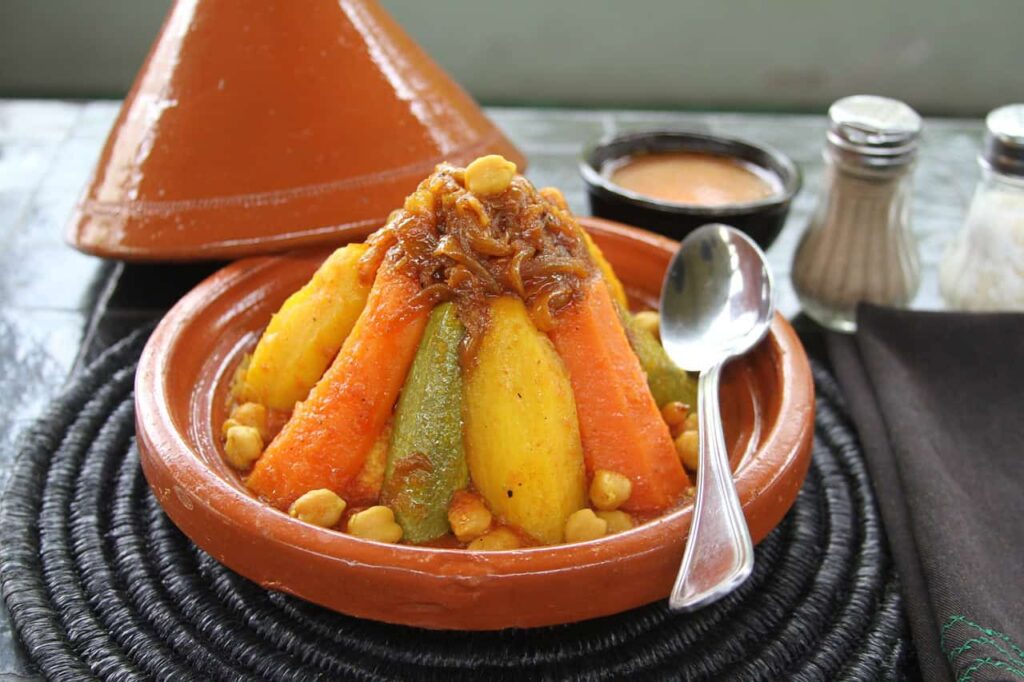
Couscous is a true treasure in Moroccan dishes, more than just a grain. It has deep roots in North African cuisine, going back generations. It’s a key part of family gatherings and celebrations.
Making couscous is an art passed down through families. Women used to spend hours rolling semolina wheat into tiny granules. Today, kitchens use quicker methods, but the tradition remains.
- Typical couscous ingredients include:
- Steamed semolina wheat
- Seasonal vegetables
- Tender lamb or chicken
- Rich spices like cumin and saffron
Friday is special for couscous in Moroccan homes. Families come together for a meal, symbolizing unity. Each region adds its own twist, with local flavors.
Home-cooked couscous is unmatched, carrying generations of tradition. When you try it, you’re not just eating – you’re experiencing Moroccan culture.
Street Food Delights in Morocco
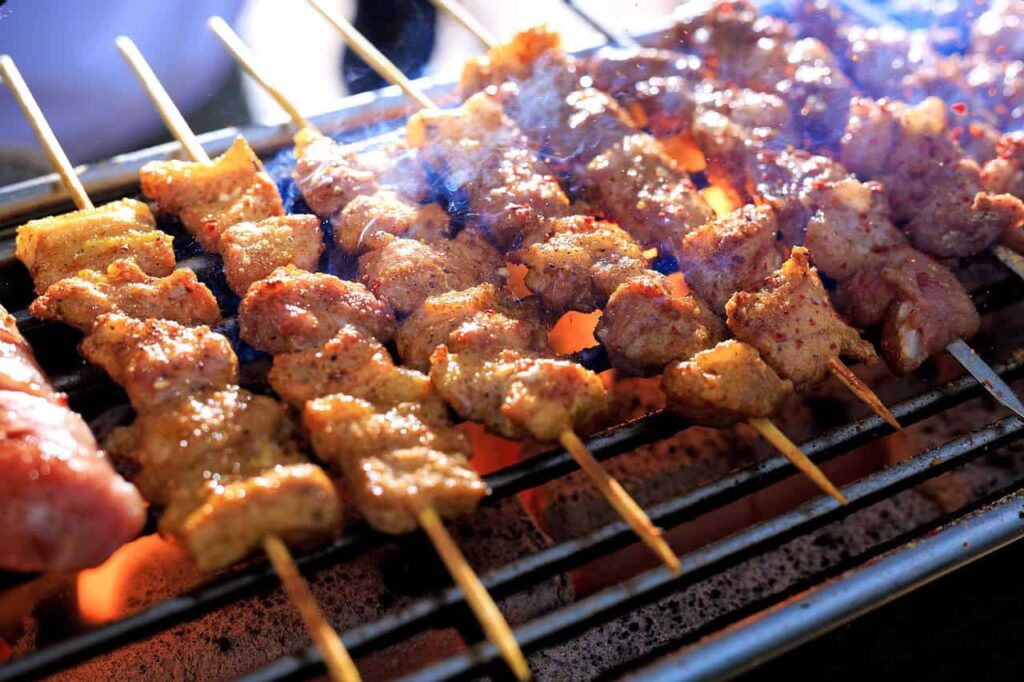
Exploring Morocco’s street food is key to any food guide. The country’s food scene is full of flavors. It offers travelers a tasty journey through markets and food stalls.
Street food in Morocco is a tasty way to learn about the country’s food traditions. From coastal cities to inland markets, these spots show the true taste of Moroccan dishes.
Best Markets for Street Food
Here are the top places for street food:
- Jemaa el-Fnaa Market in Marrakech
- Medina of Fez
- Essaouira’s Seaside Vendors
- Casablanca Central Market
Popular Street Food Options
Get ready for these tasty Moroccan dishes:
- Kebabs – Grilled meat skewers with spices
- Harira Soup – A tomato-based soup
- Sfenj – Deep-fried doughnuts
- B’stilla – A meat pie with sweet and savory flavors
Food Safety Tips
Here’s how to enjoy street food safely:
- Choose busy stalls with lots of customers
- Watch food being made fresh
- Avoid raw veggies
- Drink bottled water
- Carry hand sanitizer
By following these tips, you’ll enjoy Morocco’s street food safely. It’s a key part of the country’s culinary charm.
Traditional Moroccan Breads and Pastries
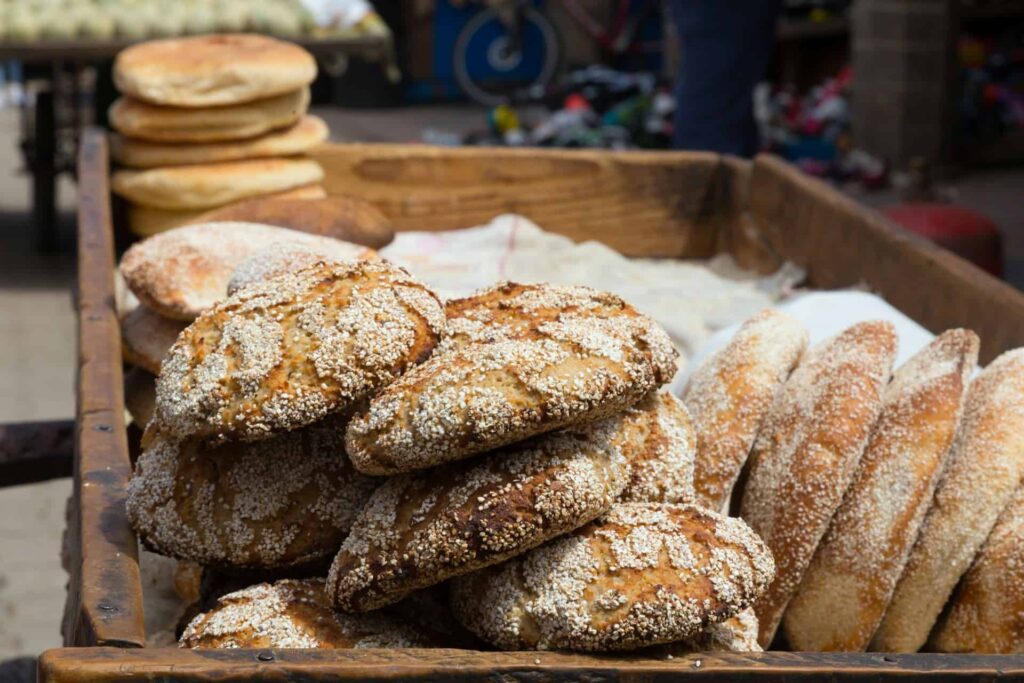
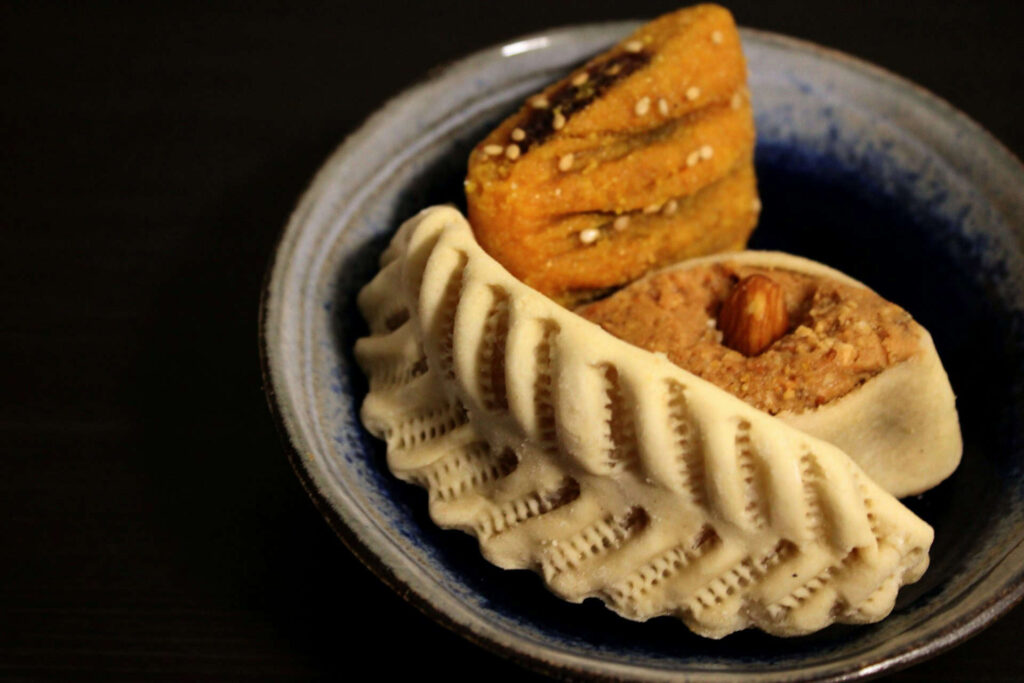
Explore the rich world of Moroccan cuisine and discover the amazing variety of breads and pastries. These are the heart of Moroccan culinary traditions. In Morocco, bread is more than just food—it’s a symbol of hospitality and community.
The key to Moroccan dishes is khobz, a round flatbread eaten with almost every meal. It’s baked fresh every day in traditional ovens. This bread is not just food; it’s a way to connect with others in the community.
- Khobz: Round white bread served with most meals
- Batbout: Soft griddle bread perfect for sandwiches
- Msemen: Flaky, layered square bread
Sweet pastries are magical in Moroccan celebrations. During festivals and special times, you’ll find delicate treats. These show the skill in baking passed down through generations.
- Briwat: Triangular pastries filled with savory or sweet ingredients
- Chebakia: Honey-soaked sesame cookies typically prepared during Ramadan
- Gazelle horns: Crescent-shaped almond-filled delicacies
Traditional baking is alive in local neighborhoods. Communal ovens are key to daily cooking. These places are not just for cooking; they’re where stories and recipes are shared across generations.
Moroccan Beverages and Tea Culture
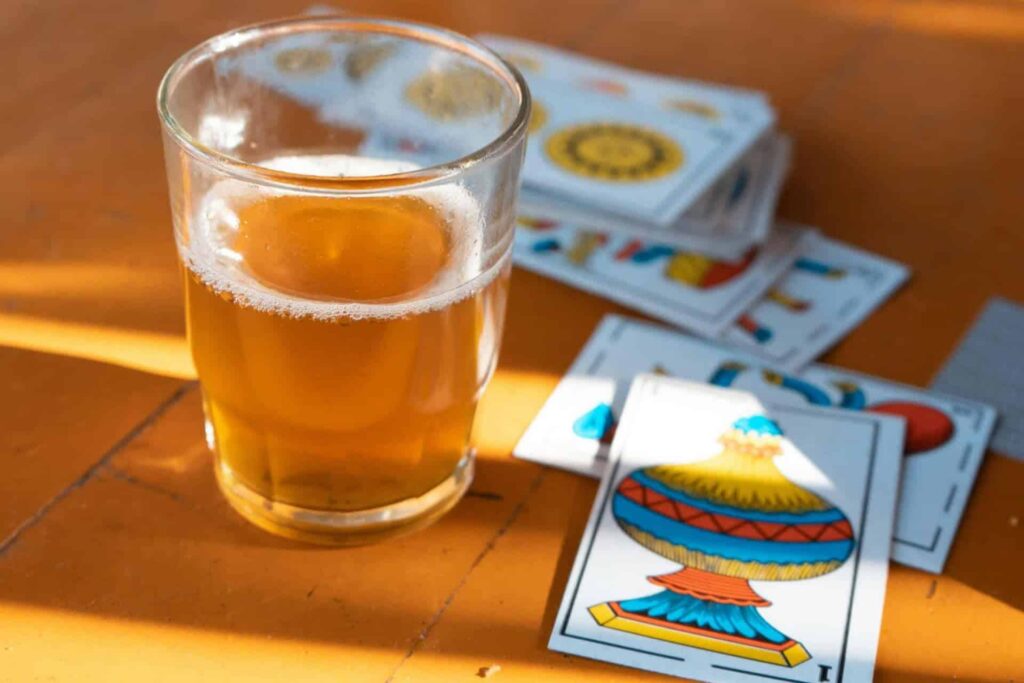
Exploring a Moroccan food guide shows how important drinks are. Moroccan drinks reveal the country’s warm culture and traditions.
The Ritual of Moroccan Mint Tea
Moroccan mint tea is a symbol of hospitality. It’s a sweet green tea with fresh mint leaves. The tea is made with care and served with ceremony.
- Boiling Chinese green tea
- Adding generous amounts of fresh mint leaves
- Incorporating substantial sugar
- Pouring from a height to create a frothy top
Traditional Coffee Houses
Morocco also has a lively coffee culture. Coffee houses are where people meet to talk and enjoy strong coffee. These places are more than coffee shops; they’re community centers.
Fresh Fruit Juices
Street markets in Morocco have many fresh fruit juices. You can find everything from orange juice in Marrakech to exotic fruits. Vendors make fresh-pressed juices right before you, showing off local traditions.
Conclusion
Your journey through Moroccan cuisine has been exciting. You’ve explored flavors, traditions, and cultural richness. This guide has shown you the vibrant world of tagines, couscous, street foods, and unique drinks.
Moroccan cuisine is diverse, showing its rich history. It combines Berber, Arabic, and Mediterranean flavors. Each dish from Marrakech’s markets to Casablanca’s kitchens shares stories of community and tradition.
Whether you’re visiting Morocco or cooking at home, Moroccan food is an experience. It’s about sharing meals, connecting with others, and celebrating every bite. Your new knowledge will excite your taste buds and deepen your understanding of this culinary world.
Keep exploring Moroccan cuisine with curiosity. Try new spices, learn cooking techniques, and enjoy the discovery of this fascinating food culture.
FAQ
What are the most important spices in Moroccan cuisine?
Moroccan cooking relies on spices like cumin, saffron, and ras el hanout. Paprika and cinnamon are also key. These spices give Moroccan dishes their unique and complex flavors.
How is a traditional Moroccan tagine prepared?
A tagine is a slow-cooked stew made in a cone-shaped pot. It’s filled with meat or veggies and spices. The pot’s shape helps keep the dish moist and flavorful.
Is Moroccan cuisine vegetarian-friendly?
Yes, it is! Moroccan dishes like vegetable tagines and couscous with roasted veggies are great for vegetarians. Even traditional dishes can be adapted for a plant-based diet.
What is the significance of mint tea in Moroccan culture?
Mint tea in Morocco is more than a drink. It’s a sign of hospitality and friendship. It’s made with green tea and fresh mint, served hot and sweet. The way it’s served is a big part of Moroccan culture.
How do Moroccans typically eat their meals?
Eating in Morocco is a family affair. Meals are shared, with everyone around the table. It’s common to use your right hand or bread to eat, making meals a social event.
What is couscous, and why is it important in Moroccan cuisine?
Couscous is Morocco’s national dish, a tiny pasta made from semolina wheat. It’s a big deal on Fridays, topped with veggies and meat. It’s more than food; it’s a symbol of community and tradition.
Are there any food safety tips for trying street food in Morocco?
When eating street food in Morocco, pick busy stalls with lots of customers. Make sure food is cooked well and drink bottled water. Avoid raw veggies without peels and look for clean food preparation areas.
What are some must-try Moroccan street foods?
Don’t miss kebabs, harira soup, sfenj (Moroccan doughnuts), b’stilla (a savory-sweet pastry), and merguez sausages. These dishes showcase Morocco’s rich culinary heritage.
